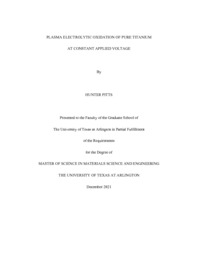
ATTENTION: The works hosted here are being migrated to a new repository that will consolidate resources, improve discoverability, and better show UTA's research impact on the global community. We will update authors as the migration progresses. Please see MavMatrix for more information.
Show simple item record
| dc.contributor.advisor | Meletis, Efstathios I | |
| dc.creator | Pitts, Hunter | |
| dc.date.accessioned | 2022-01-25T18:22:48Z | |
| dc.date.available | 2022-01-25T18:22:48Z | |
| dc.date.created | 2021-12 | |
| dc.date.issued | 2021-12-20 | |
| dc.date.submitted | December 2021 | |
| dc.identifier.uri | http://hdl.handle.net/10106/30226 | |
| dc.description.abstract | Plasma Electrolytic Oxidation (PEO) is a method of coating which is used to apply non metal coatings to different metal substrates. This process occurs in an electrochemical cell that
consists of an electrolyte, two electrodes submerged in the electrolyte and a power supply
supplying voltage to the two electrodes. The goal of this study was to observe how a constant
applied voltage would affect the coating thickness at varied applied voltage and varied
processing time.
This study was a continuation of a constant applied voltage study previously performed
in the SaNEL research group. It was continued to add more detailed thickness data, develop a
better understanding of the PEO process under constant voltage, and facilitate an undergoing
modeling effort in SaNEL by another group member. The electrolyte used in the present study
was KOH and K4P2O7, and the substrate pure Titanium (Ti) being the same as previous in
experiments for continuity.
PEO is an anodic process, which requires the positive polarity to be attached to the Ti
electrode and the negative polarity to be attached to the stainless-steel counter electrode. A
programmable power supply was used to apply constant voltage to the Ti working electrode.
Four different voltages (450, 400, 350 and 300 V) were applied to the Ti electrode at varying
processing times for each voltage. For 450 V, the processing times of 2, 10, 20, 30, 50 ,70, 100
and 150 s were selected to get a good range of time across the whole PEO process. For 400, 350
and 300 V the processing times of 50 and 100 s were selected for each.
By applying a constant voltage to the Ti substrate, as the coating increases in thickness,
the current decreases until it reaches zero. The current density can be calculated from the current
decay data and the current density decays are compared across each voltage. As voltage
increases the time for current density to decay to zero also increases, as well as the maximum
current density value being higher at higher voltages. Surface morphology, composition, and
thickness were characterized by SEM, SEM/EDS and XRD. EDS and XRD were used to
confirm the presence of Ti, O and P in the coating and offer insight into which possible
compounds are formed in the coating. It was determined that multiple Titanium oxides and
amorphous Titanium phosphates are present in the coating, with TiO2, Ti2O and TiP2O7 being the
most probable compounds found in the coating.
SEM was also used to obtain the coating cross section thickness. It was determined that
as applied voltage increased the coating thickness also increased and the coating thickness can
grow for longer times at higher applied voltage as well. The thickness values obtained for 450 V
were compared to a model made to predict oxide growth for the PEO process on Ti. The results
of this comparison found that the thickness measurements obtained experimentally matched well
with the model.
Finally, charge density calculations were conducted for each deposition and correlated to
the thickness data. The charge density is found by taking the integral of the current density
decay curve with respect to time. A plot of charge density versus thickness was made to show
the relationship between the two. It was determined that the relationship between the two is
linear and can help be used to predict the thickness based only on experimental data. If the
current density decay curve is obtained experimentally and the charge density is calculated from
this curve, the thickness can be in turn estimated. This could be a helpful tool to use alongside
the oxide prediction model to help be more accurate in trying to predict potential oxide growth at
specific PEO parameters. | |
| dc.format.mimetype | application/pdf | |
| dc.language.iso | en_US | |
| dc.subject | Plasma electrolytic oxidation | |
| dc.title | Plasma Electrolytic Oxidation of Pure Titanium at Constant Applied Voltage | |
| dc.type | Thesis | |
| dc.degree.department | Materials Science and Engineering | |
| dc.degree.name | Master of Science in Materials Science and Engineering | |
| dc.date.updated | 2022-01-25T18:22:49Z | |
| thesis.degree.department | Materials Science and Engineering | |
| thesis.degree.grantor | The University of Texas at Arlington | |
| thesis.degree.level | Masters | |
| thesis.degree.name | Master of Science in Materials Science and Engineering | |
| dc.type.material | text | |
Files in this item
- Name:
- PITTS-THESIS-2021.pdf
- Size:
- 2.769Mb
- Format:
- PDF
This item appears in the following Collection(s)
Show simple item record


